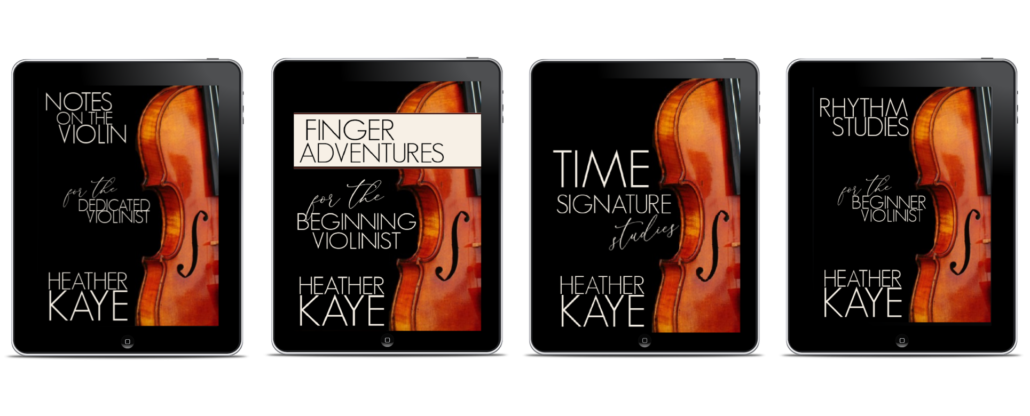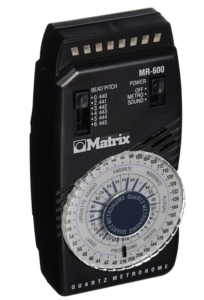How to Practice Playing with a Metronome as a Violinist
Are you struggling playing with the metronome? Do you absolutely hate the metronome? In this post, discover how to practice playing with the metronome as a violinist.
The biggest mistake I see violinists make when they play with the metronome is that it’s just clicking away with no reference to what exactly is being played. Just turning the metronome on, playing and hearing the click and not knowing if you’re playing with the metronome is not the way to practice playing with a metronome.
When you hear the click of the metronome and you play after the click, you will always be late.
How to practice playing with the metronome as a violinist
You need to understand how to anticipate the beats. For a split second before you hear the click, you should be thinking about that next beat.
How to practice playing with the metronome as a violinist? Anticipate your physical motion before the beat.
When you hear the click and then you play you will be late. So how can we practice this? The first step and literally it is the first step is not to play at all.
Improve your understanding of time signatures and rhythm plus note reading with my 100% immediately downloadable Note Reading Bundle! Get started now by clicking the image below!
Walk to the beat of the metronome
Turn your metronome on at 80 or 92 and walk to the beat of the metronome. Make sure that each foot and each step is with the click.
Why this is important is because when you put your foot down on the floor matching the beat of the metronome, there’s a moment where you had to think a second before the beat of what to do.
You had to anticipate the fact that you have to lift your leg up and set it down with the click.
This is the same in Violin playing. It’s a physical movement that we make with our arm to move the bow or to pluck with a finger and we have to think before the click in order to be with the click.
It’s not click foot or click play, you’ll be late.
You need to anticipate and play. Think about moving your body before the click in order to be exactly with a click. First step is to walk. That’s going to really help and when you step for each click, that’s your quarter notes.
The metronome pictured above is an excellent metronome to get started with. Click here to purchase.
Faster tempo
Then when we go twice as fast, that’s our eighth notes.
When you practice twice as fast with your eighth notes, you can think every click it will be with the left foot or every click will be with the right foot. That way you’re going to make sure that you are stepping the eighth notes to the beat of the metronome. Once you’re able to walk with a metronome, your quarters, and your eighths then you can bring your bow into the picture.
Walking and bowing to the beat of the metronome
Now if you find 80 for the quarter note, take your metronome down to 60. The speed is not important.
What is important, is that you’re exactly with the metronome.
Grab your bow since you will need it for this exercise. Continue walking with the beat of the metronome. While you are walking, bow down and up to each step. Practice walking and bowing to quarters and then to eighths. Once you can execute them separately practice alternating quarters and eighths.
Walking and playing to the beat of the metronome
Start with the legs. Get them going with the beat and bow open strings with each step.
It’s a bit challenging to put the legs and the arm together and then be bouncing up and down and playing the violin at the same time but it gives you that idea of how this Rhythm gets into the bow arm.
Playing with the metronome
Eventually, just take out the legs and play with the metronome without walking. Start with quarters and then eighths.
I would do that on open strings only at first. Don’t worry about notes or your left hand, just get this feeling of the rhythm in your right arm.
Give triplets a go
Now if you want to take it even further, you can apply this method to triplets. For this exercise, we will slow the metronome down to 60 because triplets are really pretty quick. What I see as the biggest mistake violinists make with triplets is the fact that they’re not equally placed. Individual notes within triplets need to be evenly distributed.
- Think trip-il-let with the metronome.
- Clap a triplet with the metronome.
- Understand that your feet will alternate with the beat of the metronome. Left right left, Right left right
- Walk the triplet rhythm to the metronome.
- Air bow while walking the triplet.
Be aware of bow direction
What I love about this exercise is the fact that as violinists when we play triplets each triplet is a different bow Direction. Our first triplet starts down, our next triplet is up.
Down up down, Up down up
You can really feel that as you’re walking it out left right left, right left right, left right left, right left right.
You can feel the fact that every triplet is a different bow direction, so it alternates. It is important to get that feeling in your bow arm.
Work only one beat at a time
So next tip I have for you is when you’re working out your rhythms whether it’s a triplet, 16th note, or a rhythmic combination between beats, is to make sure that you start on One Beat and line it up with the next beat and stop on the next beat.
That way you can really know if that triplet is being placed accurately if you are landing the next triplets with the click.
Internalizing the beat
You now have clear direction on how to internalize the beat within your body, to anticipate it, and not react to the beat of the metronome.
You now know what to do to anticipate the beat of the metronome as to not be late.
You now know how to practice playing with the metronome as a violinist.
Take this newfound feeling and implement it within pieces like a folk song or a Bach minuet and make sure that you can play exactly with some metronome from beginning to end.
That way you understand how to retrain yourself to play with a metronome and then you can take it to more difficult Advanced pieces to know that you are truly playing with a metronome and it’s not some background click that has no relationship to what you are doing.
If you like this post, I’m sure you would love to subscribe to my email newsletter where I send out every week tips on how to become a better violinist and updates on the courses that I offer online whether they are workshops, online programs or private sessions.
Have fun practicing with the metronome. Ciao.
Happy Magical Practices,
Heather is a classically trained concert violinist residing in Bulgaria. She received her BM violin performance degree from CU-Boulder, studied with top teachers including Rachel Barton Pine. Heather has held leadership positions with multiple orchestras in the Greater Chicago-Milwaukee area. She has instructed millions of violinists globally via Youtube videos, online academies, group coaching and one on one sessions. Heather’s students have won multiple awards, concerto competitions, held concertmaster positions in orchestras and even performed in Carnegie Hall. Heather is an advocate of a holistic violin lifestyle – putting one’s mind, body and spirit as a violin journey priority.
Please share in the comments which above tips you will be implementing into your daily practices sessions.







Leave a Reply
Want to join the discussion?Feel free to contribute!